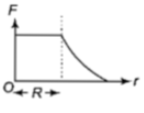Distance of geostationary satellite from the center of the Earth in terms of is-
1.
2.
3.
4.
Energy required to move a body of mass m from an orbit of radius 2R to 3R is
1.
2.
3.
4.
Radius of orbit of satellite of earth is R. Its kinetic energy is proportional to -
1.
2.
3. R
4.
Two satellite A and B, ratio of masses 3 : 1 are in circular orbits of radii r and 4r. Then ratio of total mechanical energy of A to B is
1. 1 : 3
2. 3 : 1
3. 3 : 4
4. 12 : 1
A satellite moves round the earth in a circular orbit of radius R making one revolution per day. A second satellite moving in a circular orbit, moves round the earth once in 8 days. The radius of the orbit of the second satellite is -
1. 8 R
2. 4R
3. 2R
4. R
At what height from the surface of earth the gravitation potential and the value of g are and respectively? (Take, the radius of earth as 6400 km.)
1. 1600 km
2. 1400 km
3. 2000 km
4. 2600 km
A remote sensing satellite of earth revolves in a circular orbit at a height of 0.25 x 106 m above the surface of earth. If earth’s radius is 6.38x106 m and g=9.8ms-1, then the orbital speed of the satellite is
1. 7.76kms-1
2. 8.56kms-1
3. 9.13kms-1
4. 6.67kms-1
A satellite S is moving in an elliptical orbit around the earth. The mass of the satellite is very small as compared to the mass of the earth. Then,
1. the angular momentum of S about the centre of the earth changes in direction, but its magnitude remains constant
2. the total mechanical energy of S varies periodically with time
3. the linear momentum of S remains constant in magnitude
4. the acceleration of S is always directed towards the centre of the earth
Which one of the following plots represent
the variation of gravitational field on a
particle at distance r, due to a thin
spherical shell of radius R? (r is measured
from the centre of the spherical shell).
1.
3. 
The dependence of acceleration due to gravity g on the distance r from the centre of the earth assumed to be a sphere of radius R of uniform density is as shown in the figure below -

(1) (2)

(3) (4)
The correct figure is
1. (1)
2. (3)
3. (2)
4. (4)










